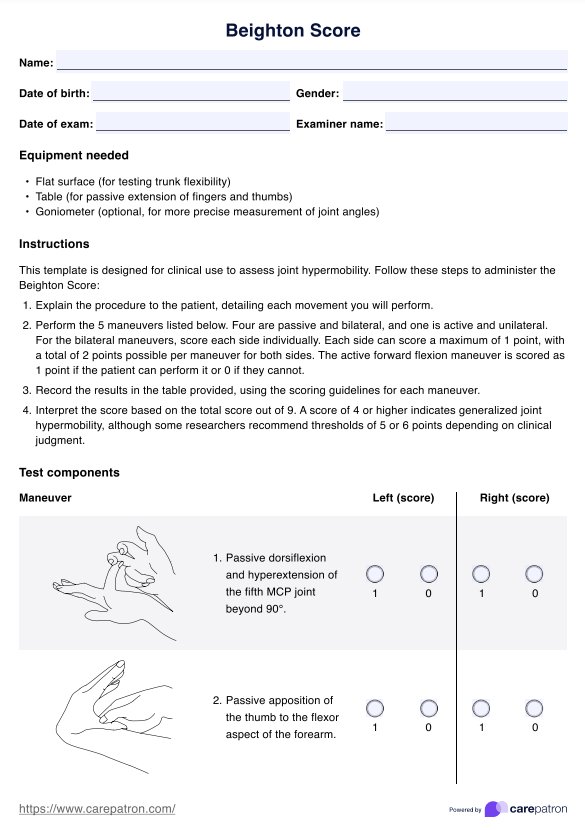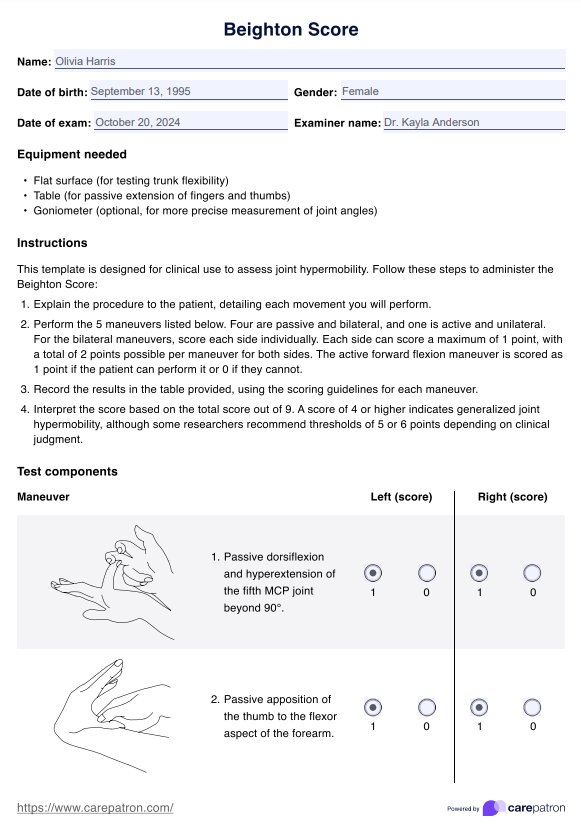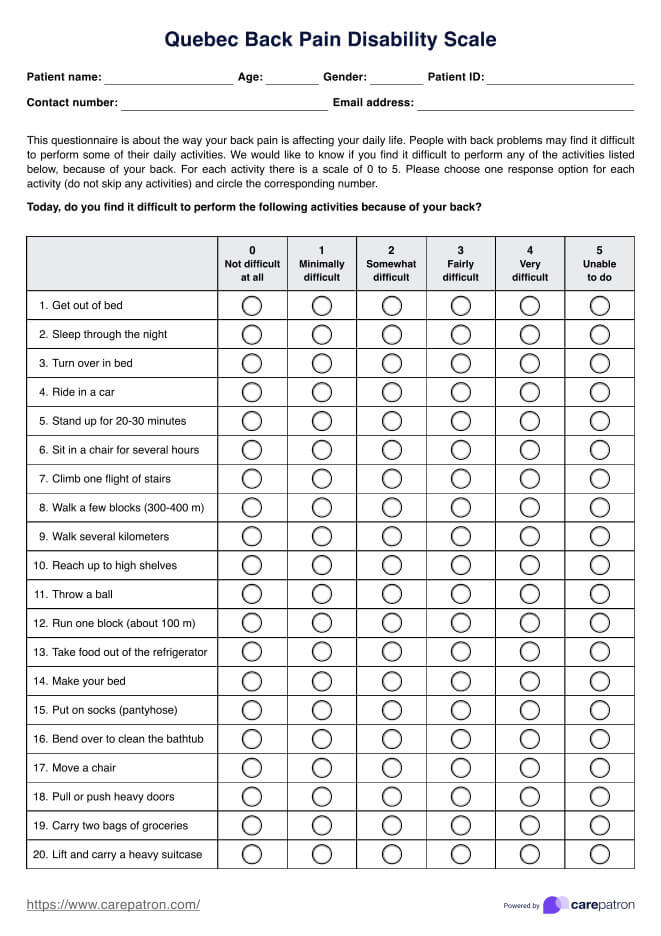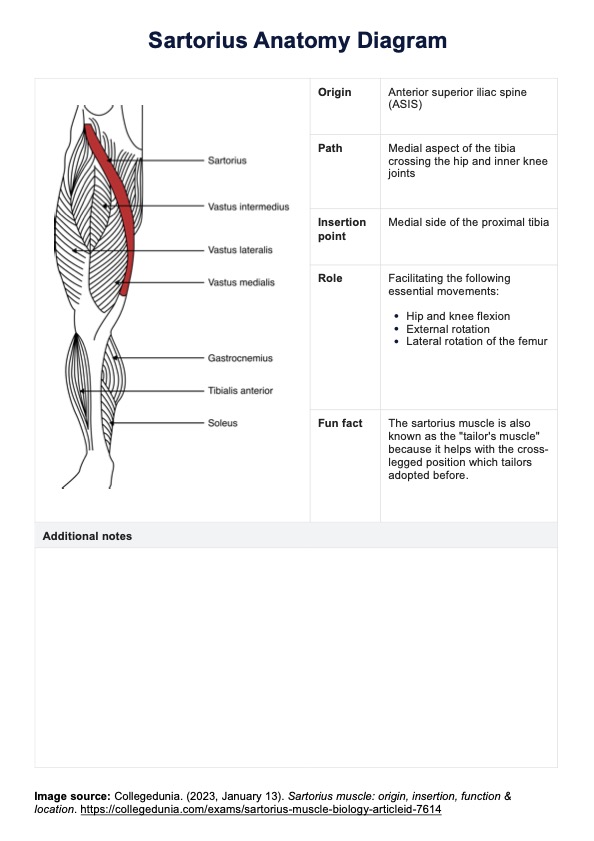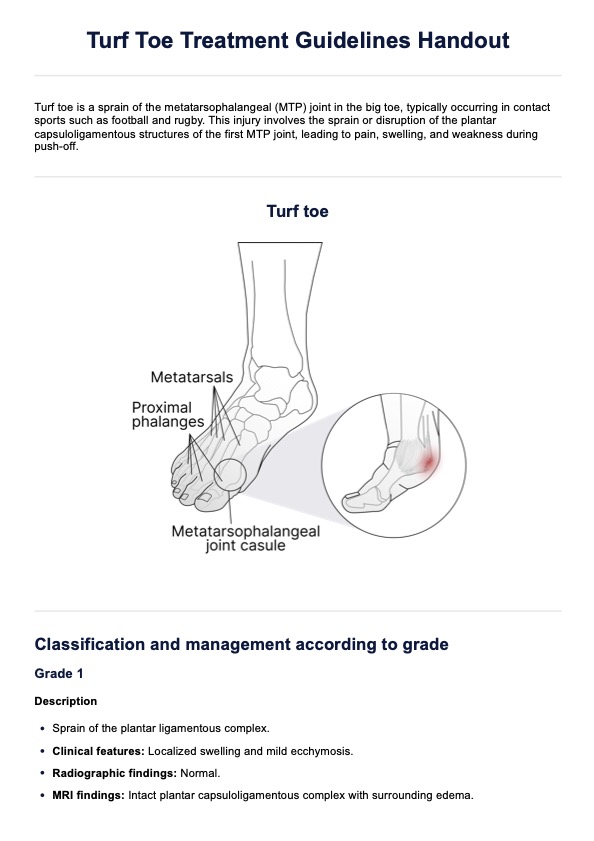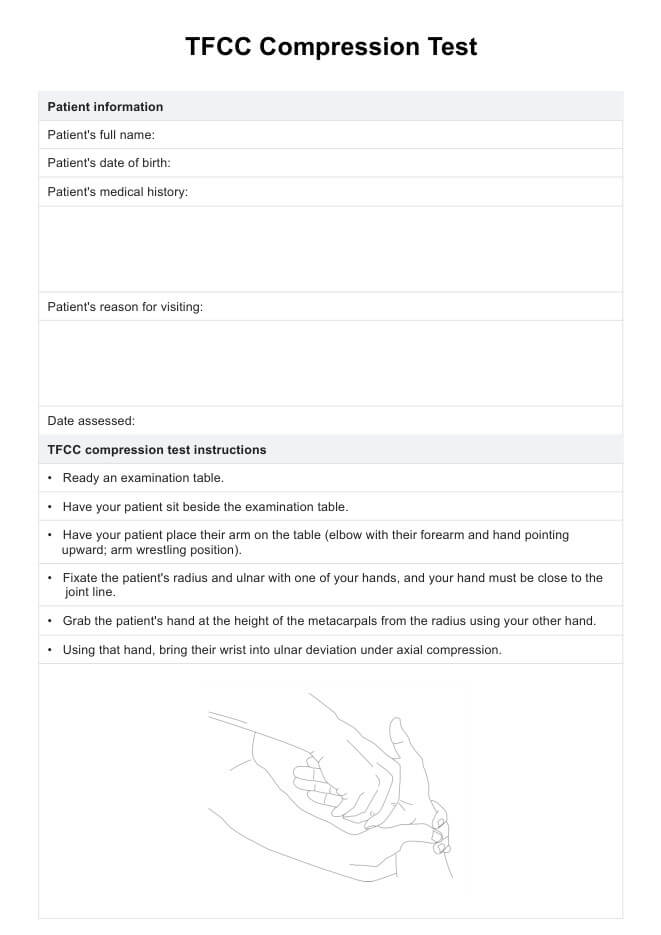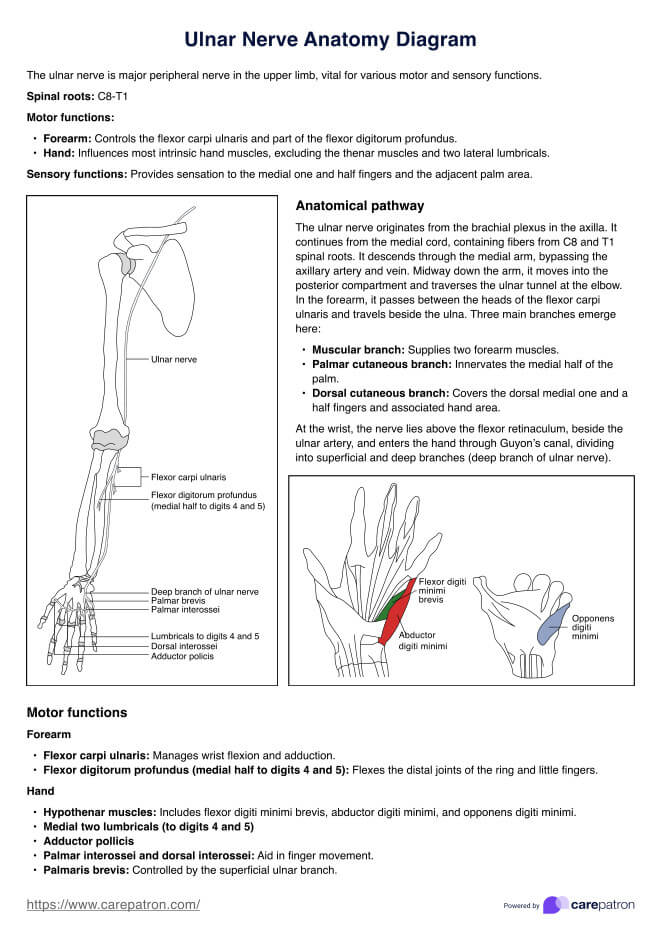Beighton Score
Assess joint hypermobility efficiently with our Beighton Score Template. Download the free PDF for accurate clinical evaluation, scoring, and interpretation.


What is joint hypermobility syndrome?
Joint hypermobility syndrome (JHS), also known as generalized joint hypermobility (GJH), is a condition where individuals exhibit generalized hypermobility and an extensive range of motion in their joints. This hypermobility can sometimes lead to joint pain, instability, and an increased risk of injury. JHS is often linked to connective tissue disorders like Ehlers-Danlos syndrome, which affects collagen and other structural proteins in the body.
Identifying joint hypermobility early is critical for preventing complications and effectively managing symptoms. The Beighton Score is widely used to assess joint hypermobility, providing healthcare professionals with a simple and reliable method to screen for this condition.
Beighton Score Template
Beighton Score Example
What is the Beighton Score?
The Beighton Score is a screening tool developed to assess joint hypermobility by measuring flexibility in critical joints. This nine-point scoring system evaluates five specific maneuvers that test for excessive joint movement. Introduced by Dr. Rodney Beighton in the 1970s, the Beighton Score has become a cornerstone in diagnosing generalized joint hypermobility. It is beneficial for identifying individuals at risk for conditions like benign joint hypermobility syndrome or Ehlers-Danlos syndrome.
With its simplicity and effectiveness, the Beighton Score remains one of the most widely used methods to quantify joint laxity. Healthcare professionals rely on this tool to guide treatment decisions, ensure accurate diagnoses, and monitor the progression of joint hypermobility in their patients.
How to use our Beighton Score Template
Our Beighton Score Template simplifies evaluating joint hypermobility by offering a structured, easy-to-follow format. Follow the steps below to use the template effectively in your clinical practice.
Step 1: Download the Beighton Score PDF template
Begin by downloading the Beighton Score Template from Carepatron's platform. This user-friendly template is designed to guide healthcare professionals through assessing joint hypermobility.
Step 2: Gather the necessary equipment
Before starting the assessment, ensure you have a ruler or goniometer (optional) to measure the range of motion. A goniometer can measure the joint angle as part of the Beighton Scoring System. The patient should be in comfortable attire and positioned flat on the floor on a flat surface for accurate joint evaluation.
Step 3: Perform the Beighton Score assessment
The Beighton Score involves evaluating the flexibility of five key joints:
- Fingers: Ask the patient to extend their little fingers backward beyond 90 degrees with the forearm flat on a surface.
- Thumbs: Instruct the patient to move their thumbs toward their forearms. Repeat this for both hands.
- Elbows: Have the patient extend their elbows backward beyond 10 degrees of hyperextension.
- Knees: Ask the patient to stand and extend their knees backward beyond 10 degrees. The lower limb assessment score is crucial in evaluating joint hypermobility, highlighting its reliability and validity in clinical settings.
- Trunk flexion: Request that the patient bend forward and attempt to touch their palms flat on the floor while keeping their legs straight.
Step 4: Record the results
For each successful maneuver, assign 1 point. Bilateral joints, such as the fingers, thumbs, elbows, and knees, can each score a maximum of 2 points (1 per side). The forward trunk flexion is scored out of 1. Record the results for each joint in the template.
Step 5: Calculate the Beighton Score
Add the points from the recorded maneuvers to calculate the total Beighton Score. The maximum possible score is 9, with higher scores indicating greater joint hypermobility.
Results and interpretation
The Beighton Score quantitatively measures joint hypermobility, ranging from 0 to 9. This score helps healthcare professionals assess the severity of joint laxity and clinical decisions. The template uses the normative scores from an Australian sample outlined in the study by Singh and colleagues (2017), which are categorized into age groups and sex. This then determines a positive or negative result:
- Positive: Indications of hypermobility. Further evaluation may be necessary to assess for related conditions.
- Negative: No significant hypermobility and typically rules out conditions associated with joint hypermobility.
Benefits of using our template
Accurate and efficient documentation is crucial for assessing joint hypermobility, and Carepatron’s Beighton Score Template offers healthcare professionals an invaluable tool for this purpose. Here’s why using our template can improve your practice:
Standardized assessment
Consistency in assessments is vital for reliable patient evaluations, especially when diagnosing conditions like joint hypermobility. Carepatron's template ensures that each patient undergoes the same set of tests, following a uniform process that promotes accuracy and minimizes the risk of overlooking critical information. This standardization is essential for healthcare professionals who work across different settings and need to maintain high-quality clinical documentation.
Easy documentation
Our template simplifies the often-complicated process of recording results. With predefined fields for patient information, joint assessment, and scoring, healthcare professionals can efficiently document findings without the hassle of manually creating records. This ease of documentation allows practitioners to focus more on patient care and less on administrative tasks, improving workflow efficiency.
Support for clinical decision-making
The Beighton Score Template aids healthcare providers in making informed clinical decisions by providing a structured format for joint hypermobility assessment. Whether diagnosing hypermobility syndromes or planning treatment interventions, the detailed results from the Beighton Score Template offer a clear foundation for patient management. This improves patient outcomes and helps guide effective treatment planning, such as physical therapy or lifestyle modifications.
Reference
Singh, H., McKay, M., Baldwin, J., Nicholson, L., Chan, C., Burns, J., & Hiller, C. E. (2017). Beighton scores and cut-offs across the lifespan: cross-sectional study of an Australian population. Rheumatology, 56(11), 1857–1864. https://doi.org/10.1093/rheumatology/kex043
Commonly asked questions
A normal Beighton Score ranges from 0 to 3, suggesting no significant joint hypermobility. Most individuals within this range exhibit typical joint mobility.
A Beighton Score of 6 indicates possible joint hypermobility, which may require further evaluation, especially if the patient presents with symptoms like joint pain or knee instability.
Yes, it is possible for children to have Ehlers-Danlos syndrome (EDS) with a low Beighton Score, as the condition encompasses various subtypes. A low score does not exclude the possibility of EDS.


